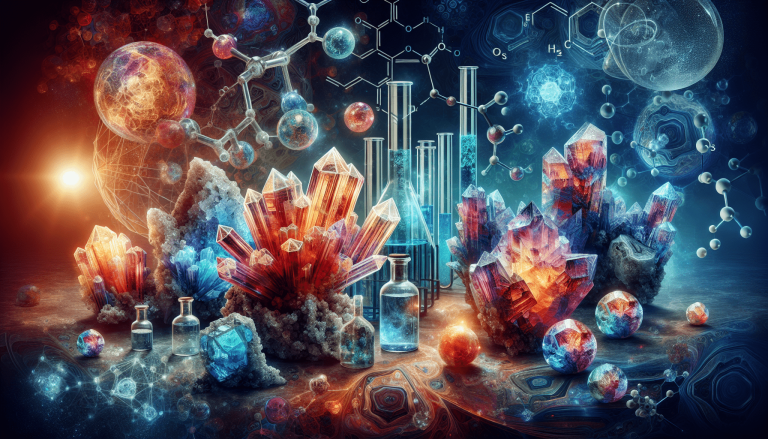Exploring The Impact Of Chemical Properties On Mineral Formation
Have you ever wondered how minerals are formed and what factors influence their formation? In this article, we will delve into the intriguing world of mineral formation and explore the profound impact that chemical properties have on this fascinating process. By understanding the role that chemical properties play in mineral formation, we can gain valuable insights into the earth’s geological history and better comprehend the intricate workings of our planet. Join us on this enlightening journey as we uncover the secrets behind the formation of minerals and the significant role that chemistry plays in shaping our world.
Introduction
When we think of minerals, we often imagine rare gems, sparkling crystals, or rocks with unique colors and patterns. But have you ever wondered about the science behind how these minerals are formed? The answer lies in the chemical properties of minerals and their interactions with various factors. In this article, we will delve into the fascinating world of mineral formation and explore the impact that chemical properties have on this process.
Chemical Properties of Minerals
Before we dive into the details, let’s first define what chemical properties are in the context of minerals. Chemical properties refer to the characteristics of a substance that can only be observed or measured when the substance undergoes a chemical change. In the case of minerals, these properties include their composition, reactivity, and stability.
Examples of chemical properties in minerals vary widely. Some minerals may be highly reactive when exposed to certain substances, while others remain inert. Some minerals may have a specific color or luster due to their chemical makeup and crystal structure, while others may exhibit fluorescence or even change color when exposed to light.
The role of chemical properties in mineral formation is instrumental. It is the combination of specific elements and compounds, as well as the conditions under which they form, that determines the type of mineral that will be produced.

Mineral Formation Process
Minerals form through a variety of geological processes, including the formation of igneous, sedimentary, and metamorphic rocks. Understanding these processes is crucial for comprehending the role of chemical properties in mineral formation.
Igneous Rock Formation
Igneous rocks are formed when molten rock, known as magma or lava, cools and solidifies. During this process, minerals crystallize and form within the rock. The chemical properties of the magma, such as its composition and temperature, play a vital role in determining which minerals will crystallize and their characteristics.
Sedimentary Rock Formation
Sedimentary rocks are formed through the accumulation of sediments, which can be derived from various sources such as weathering, erosion, and deposition. Over time, these sediments are compacted and cemented together to form sedimentary rocks. The chemical properties of the sediments and the environment in which they are deposited contribute to the types of minerals that will be present in the rock.
Metamorphic Rock Formation
Metamorphic rocks are formed through the transformation of pre-existing rocks due to changes in temperature, pressure, and chemical environment. These changes cause minerals within the rocks to recrystallize and form new minerals. The chemical properties of the original minerals, as well as the conditions under which the metamorphism occurs, influence the types of minerals that will be formed.
Chemical Properties that Influence Mineral Formation
Now that we understand the different processes of mineral formation, let’s explore the specific chemical properties that have an impact on this process.
Temperature
Temperature plays a crucial role in mineral formation. High temperatures can facilitate the melting of minerals and rock, leading to the formation of magma. As the magma cools, minerals crystallize and solidify. The rate at which the magma cools also affects the size and shape of the resulting mineral crystals.
On the other hand, low temperatures can slow down or inhibit mineral formation. Certain minerals require specific temperature ranges for their formation, and extreme cold can hinder the crystallization process.
Pressure
Pressure is another important factor that influences mineral formation. High pressures, typically found deep within the Earth’s crust, can cause minerals to undergo chemical reactions and rearrange their atomic structures. This process, known as metamorphism, leads to the formation of new minerals with distinct properties.
Conversely, low pressure can result in the release of gases and the breakdown of minerals. The absence of pressure can also lead to the formation of porous or less dense minerals.
Chemical Composition
The chemical composition of the minerals themselves plays a significant role in their formation. Different types of minerals have distinct chemical compositions, and the availability of specific elements and compounds will determine which minerals can form.
For example, the presence of silica (SiO2) is crucial in the formation of quartz. Similarly, the presence of specific metals and compounds can result in the formation of minerals such as hematite, calcite, or halite.
pH Level
The pH level, or acidity, of the environment can also influence mineral formation. Different minerals have different pH requirements for their formation. In acidic environments, certain minerals may dissolve or react with the surrounding substances, leading to the formation of new minerals.
Conversely, alkaline pH levels can promote the growth and formation of specific minerals. This is often observed in environments with high concentrations of carbonate ions, which can lead to the formation of minerals such as limestone or dolomite.
Presence of Impurities
Impurities, such as trace elements or foreign substances, can significantly impact the properties of minerals. These impurities can introduce color, alter crystal structures, or even influence the stability and reactivity of minerals.
Impurities can arise from various sources, including the surrounding rock, fluids, or gases during the formation process. The presence of impurities can result in variations in mineral properties, creating unique minerals with different colors, textures, or other distinguishing characteristics.

Conclusion
The formation of minerals is a complex process that is heavily influenced by the chemical properties of the substances involved. Temperature, pressure, chemical composition, pH level, and the presence of impurities all play essential roles in determining the type and characteristics of the minerals that are formed.
Understanding these chemical properties and their impact on mineral formation provides us with valuable insights into the geological processes that shape our planet’s composition. It also enhances our appreciation for the beauty and diversity of minerals that we encounter in our everyday lives. So, the next time you hold a beautiful gem or gaze at a breathtaking crystal, take a moment to marvel at the chemical properties that went into its formation.







